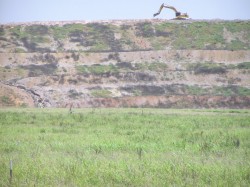Minimising your Environmental Impact
The potential impact that your business can have on the environment is becoming increasingly important, and environmental impacts and breaches can pose a significant reputation risk to your organisation.
USSA Global have the in-house and contracted capabilities to develop and deliver practical and innovative environmental management solutions, which are specifically tailored to meet your organisation’s requirements.
Environmental Management Capabilities

- Development of Environmental Management System (EMS) and Plans; either stand alone in line with ISO 14001 or as part of an Integrated HSEQ Management System
- Environmental Auditing to ISO 14001
- Environmental Legal Compliance Assessment
- Undertaking environmental planning
- Environmental Impact Assessments
- Environmental Policy development
Environmental Management Systems
The need to develop, implement and maintain a compliant Environmental Management System (EMS) is vital, in order to minimise the environmental impact of your business activities and minimise the potential repercussions, particularly in terms of public scrutiny and reputational damage.
USSA Global can assist you to establishing a sustainable and cost effective EMS, either as a stand-alone system in line with ISO 14000 set of Standards, or as part of your organisation’s Integrated HSEQ Management System.

Advising on Mining’s Environmental Clean Up Costs
A recent article in Sydney’s The Saturday Paper reported that as the mining boom ends “poor oversight and lax bonds (have left) governments stuck with an enormous bill for mining’s clean-up”.
Dubbed as “Mining’s multi-billion-dollar black hole”, our affiliate, Mike Slight, who specialises in mine closures, talks about the issue and how he can support mining companies in meeting regulator and community expectations.
Special Article: Mike Slight and Associates
“Over the last thirty years or so, mine closure performance across the mining industry had been less than adequate, with many mining operations abandoned by their owners and mine legacies left to the regulators and community for management and clean-up. Poor performance by the industry is used by non-government organisations (NGO’s) and other community groups to pressure governments to impose significant mine closure planning, financial assurance and bonding, and final rehabilitation commitments on mining companies prior to and during the development and operation of mining projects.
In recent times, with the industry’s focus on the protection of its “Social Licence to Operate” (SLTO) there has been a significant improvement in the industry’s closure performance. This improvement has been strongly supported by the development of the International Council on Mining Metals (ICMM) Sustainable Development Framework and Principles, the Minerals Council of Australia’s (MCA) Enduring Value Framework for Sustainable Development and the GRI Sustainability Reporting Framework, with many mining companies becoming signatories to these Global and Australian initiatives.
Despite this improving commitment and performance by the industry there are still many resource development organisations who are failing to meet these commitments resulting in many Australian Regulators introducing many changes to their resource development regulations including more significantly a focus on closure planning guidelines (embedded in legislation), abandoned mine levies (royalties) to pay for rehabilitation and clean-up of the industry abandoned mine legacies, and more onerous Environmental Financial Assurance (bonding) requirements. In addition Regulator project approval processes and requirements are focusing more on mine closure planning and progressive rehabilitation strategies and commitments, environment and community impact assessments and cumulative impacts of the development of resources on the environment and the community.
We can help your organisation to meet these regulator and community expectations.
To find out more, contact Mike Slight & Associates at: http://www.mikeslightandassociates.com.au/
